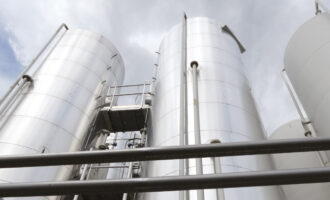ASTM unveils ground-breaking 100 octane fuel for spark ignition engines
On 13 March 2017, international standards organisation ASTM announced the release of ASTM D8076-17, a brand-new specification for 100 Research Octane Number (RON) Test Fuel, aimed at automotive spark-ignition engines. The new standard was developed by ASTM’s committee on petroleum products, liquid fuels, and lubricants (D02). For several years, engine manufacturers have been grappling with the optimal approach to achieving a broadly accepted specification for high octane fuel, thus, ASTM’s announcement is a major break-through for the global automobile industry.
Spark ignition engines are becoming increasingly complex. Car engine manufacturers are continually innovating; a raft of technology developments aimed at minimizing gasoline consumption include higher compression ratios, elevated power densities, increased turbocharger boost pressures, smaller swept displacement volume and lower engine speeds.
Robert McCormick, an ASTM member who spearheaded the task group responsible for the formation and approval of the new standard, says that “engines that use these [new] technologies require a significantly higher octane fuel than what is widely available to consumers today to achieve their full efficiency potential.” He says, “automakers must design their engines to operate on a common fuel that is broadly available in the marketplace.”
While the stated fuels are not yet commercially available, the new specification is intended for developing engine technologies and is a critical step towards commercialisation. In a complex industry where specifications are increasingly trailing technology developments, the release of this new 100 RON standard will provide a template for the development of a vehicle certification test fuel. ASTM also discloses that the new specification could “help specify fuels for fleet trials of prototype vehicles.”
The standard includes fuels containing both fossil and bio-derived components, and allows for the presence of oxygenates, such as alcohols and ethers, of up to 50% by volume. Methanol based fuels are not included in the specification, but may be added, according to McCormick.
Engine knock, or pinging, occurs when the air-fuel mixture within the cylinder of a spark engine auto-ignites in localised areas ahead of the flame front progressing from the spark. Subsequent abnormally high pressures and temperatures can inflict damage on engine components. While engine design and operation, as well as atmospheric conditions, are contributing factors of engine knock, antiknock rating and volatility are typical characteristics of automotive spark-ignition engine fuels.
RON and octane sensitivity are critical performance parameters for fuels described in the new specification. A high RON and high octane sensitivity have been correlated with improved knock resistance alongside aforementioned engine developments – such as higher compression ratios, turbocharger boost pressures, downspeeding and downsizing. A minimum motor octane number (MON) is also required to guarantee antiknock performance in a variety of ambient conditions.
 McCormick, principal engineer at the United States Department of Energy’s National Renew able Energy Laboratory (NREL), believes the new standard will support innovation in the automobile industry as higher performing engines are released into the global marketplace. There is growing optimism that the standard will also stimulate growth within the ethanol industry, owing to ethanol’s powerful octane boosting properties.
McCormick, principal engineer at the United States Department of Energy’s National Renew able Energy Laboratory (NREL), believes the new standard will support innovation in the automobile industry as higher performing engines are released into the global marketplace. There is growing optimism that the standard will also stimulate growth within the ethanol industry, owing to ethanol’s powerful octane boosting properties.
Several industry partners have been quick to lend their support to ASTM’s efforts in releasing the new specification. In particular, Growth Energy Chief Executive Officer Emily Skor called the new standard a “significant milestone,” stating that optimizing engines for up to 50% ethanol will be a “victory for engine performance, the environment and the American consumer.”
ASTM is a global leader in the development and delivery of voluntary consensus standards, with more than 12,000 ASTM standards implemented throughout the world to enhance product quality, promote safety, strengthen trade and provide improved customer assurance.
However, perhaps the most noteworthy aspect of ASTM’s recent effort is the process itself. ASTM International’s subcommittee on gasoline and gasoline-oxygenate blends (D02.A0.01), was “shoulder tapped” by car engine manufacturers in 2015 and asked to develop the new standard. McCormick was appointed as technical lead owing to his extensive experience in establishing and updating ASTM standards, such as E85 (D5798), B100 for blending (D6751) and biodiesel blends (D7467).
Subsequently, the 100 Research Octane Number Test Fuel was developed and published in a single year. Routinely, new automotive standards can take several years from concept to completion, owing to a rigorous process and multifaceted stakeholder approvals. Skor attributes the achievement of the standard in “record time” to a “tremendous partnership among the automotive, agriculture and ethanol industries” who contributed to the ASTM sub-committee.
American Coalition for Ethanol Senior Vice President, Ron Lamberty, says the process indicates automobile manufacturers are “serious about moving toward higher compression, high-efficiency engines that require high-octane fuel, and could benefit from the specific type of high octane offered by ethanol.”
While we may still be some way off the release of a commercial 100 RON fuel into the market, the availability of the new specification allows for its introduction when emerging engine technologies necessitate its requirement. ASTM advises that the specification is “under continuous review” to ensure it captures the latest technology shifts. The organisation says revisions may be based on “changes in fuel, automotive requirements, or test methods, or a combination thereof” and thus implores those affected to revert to the latest edition at all times.








